Powerful SEO audit essentials in 2025 focus on enhancing visibility, speed, and user experience. Growing companies must prioritize technical health, on-page optimization, and quality content. Key areas include fixing crawl errors, improving page load times, refining meta tags, and updating outdated content. Tools like Ahrefs, Screaming Frog, and Google Search Console simplify performance tracking. A strategic audit ensures search engines can easily access, understand, and rank your website, laying the foundation for long-term growth and higher organic traffic.
Powerful SEO Audit Essentials for Growing Companies in 2025
SEO | PageSpeed Insights | Google Analytics
In the fast-paced digital landscape of 2025, performing an effective SEO audit is no longer optional it’s vital for growth. Whether you’re a startup or an established business, your online visibility depends on how well your site performs in search engines. A comprehensive audit uncovers issues, boosts performance, and aligns your SEO campaign with success.
What Is an SEO Audit?
An SEO audit is a comprehensive health check of your website to assess how well it performs in search engine results. It involves evaluating technical components, on-page elements, and even your site’s content structure to pinpoint strengths, weaknesses, and missed opportunities. This process helps uncover what’s preventing your website from ranking higher and drives a strategy for improved visibility, better search performance, and ultimately more organic traffic.
SEO audits are essential, whether you’re launching a new site or maintaining an existing one. They provide data-driven insights to fine-tune your SEO strategy and ensure your website aligns with search engine algorithms and user expectations.
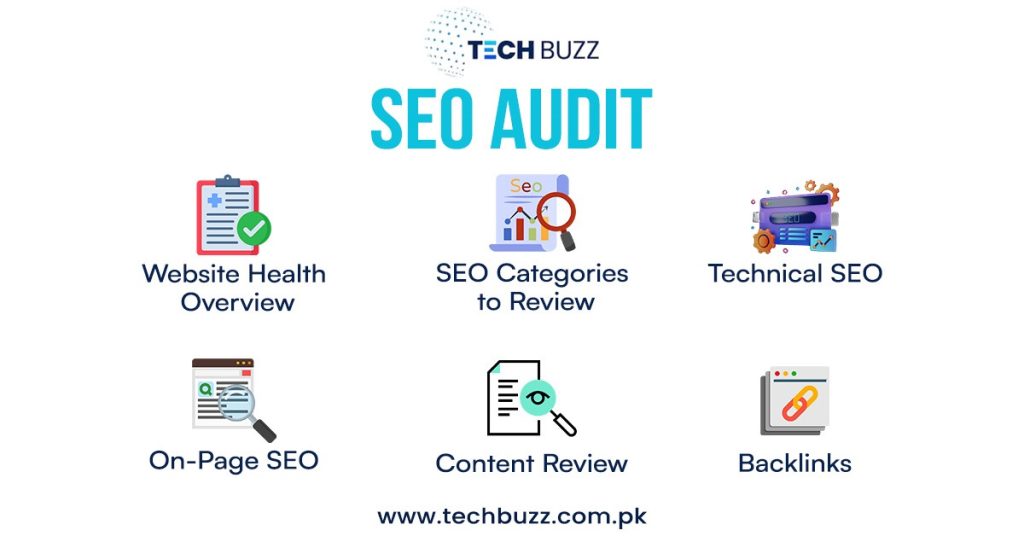
Benefits of Regular SEO Audits
Improve Loading Speed and Page Rendering
Faster websites deliver better user experiences. Audits reveal slow-loading elements, helping you speed up performance for lower bounce rates and better rankings.
Fix Crawl Errors and Improve Crawlability
Ensure search engines can properly access and index your site. Audits detect broken links, incorrect redirects, or blocked pages that hinder crawl efficiency.
Refine Meta Tags, Like the Title Tag and Meta Description
Well-optimized tags improve click-through rates. SEO audits help rewrite or enhance meta tags for better keyword alignment and search intent targeting.
Strengthen Internal Linking Structure
Audits uncover gaps or opportunities in your site’s internal links, which helps spread authority and improves page discoverability.
Boost Organic Traffic
Audits directly contribute to better rankings and higher organic traffic over time by fixing technical errors and enhancing content.
Stay Updated with SEO and Google Trends
Regular SEO audits help you adapt to algorithm updates, new Google Search Console features, and evolving ranking factors.
Essential SEO Audit Components You Can’t Ignore
A complete SEO audit isn’t just fixing broken links or inserting keywords. It’s about creating a solid structure that helps your website perform better in search engine rankings while improving user experience. Below are the key components of an effective SEO audit that growing companies in 2025 must prioritize:
1. Technical SEO Audit
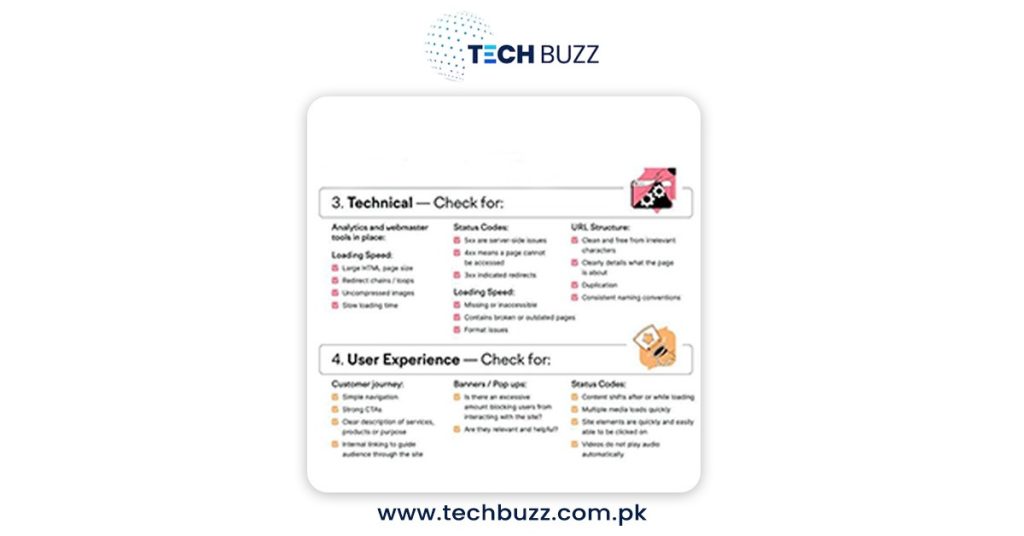
A technical seo audit checks whether search engines can crawl, index, and understand your website effectively. Without proper technical foundations, even the best content won’t rank.
Key Technical Checks:
- Crawlability: Use tools like Google Search Console to find blocked pages, crawl errors, and sitemap issues. Ensuring your robots.txt file and sitemap are optimized can significantly boost visibility.
- Indexability: All important pages should be indexable. Use the “site:” search operator on Google or tools like Screaming Frog to detect noindex tags or canonical errors.
- Loading Speed: A slow site kills both SEO and user experience. Use PageSpeed Insights to identify what’s slowing down your pages and implement fixes such as image optimization, lazy loading, and code minification.
- Page Rendering: It’s not enough for bots to crawl your content—they must also render it. Test your page with Google’s URL Inspection tool to see how it appears to crawlers.
- Mobile Responsiveness: With mobile-first indexing, your site must perform well on all devices. Use tools like Mobile-Friendly Test to ensure your design adapts correctly.
- HTTPS Security: Secure your domain with SSL. Sites with HTTPS have a trust edge over non-secure domains.
2. On-Page SEO Audit
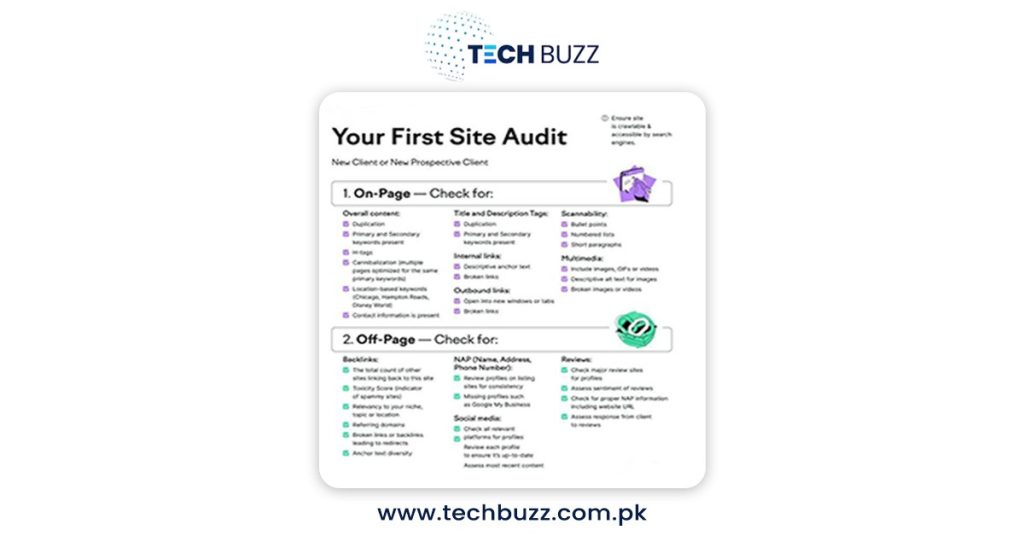
A strong On-Page SEO Audit ensures each webpage is fully optimized for both users and search engines. These optimizations directly influence your ability to rank for target keywords.
On-Page Must-Haves:
- Title Tags: Each page must have a unique and relevant title tag incorporating the primary keyword. Keep it under 60 characters.
- Meta Descriptions: Write accurate, compelling meta descriptions that include your target keywords. They don’t directly impact ranking but improve click-through rates.
- Headings (H1–H6): Use clear, structured headings. Your H1 should describe the page topic, while H2s and H3s organize subtopics.
- Internal Linking: Use internal linking to connect relevant pages. This spreads link equity and improves crawlability.
- Structured Data: Leverage schema markup to help search engines understand your content better and increase the chance of rich snippets.
- Image Optimization: Use descriptive file names and ALT attributes, and compress images without losing quality to speed up loading.
- URL Structure: Keep URLs short, keyword-rich, and readable.
3. Content Audit
A Content Audit reviews the overall health, quality, and relevance of your content. This helps remove weak pages and enhance your top-performing assets.
Things to Check:
- Content Quality: Are your blog posts current, informative, and actionable? Outdated or shallow content can hurt rankings.
- Keyword Integration: Ensure keywords are naturally placed in the intro, subheadings, and throughout the text without stuffing.
- Duplicate Content: Use tools like Copyscape or Siteliner to find and fix duplicate content.
- Thin Content: Pages with little value or under 300 words should be expanded or merged with others.
- Content Gaps: Use tools like SEMrush or Ahrefs to identify missing content opportunities based on competitors.
- Content Performance: Analyze traffic data structures to see which pieces bring in organic traffic and which don’t.
- Manual Review: No tool beats a manual review. Read each post to check for tone, voice, factual accuracy, and formatting.
Using Tools to Perform SEO Audits Efficiently
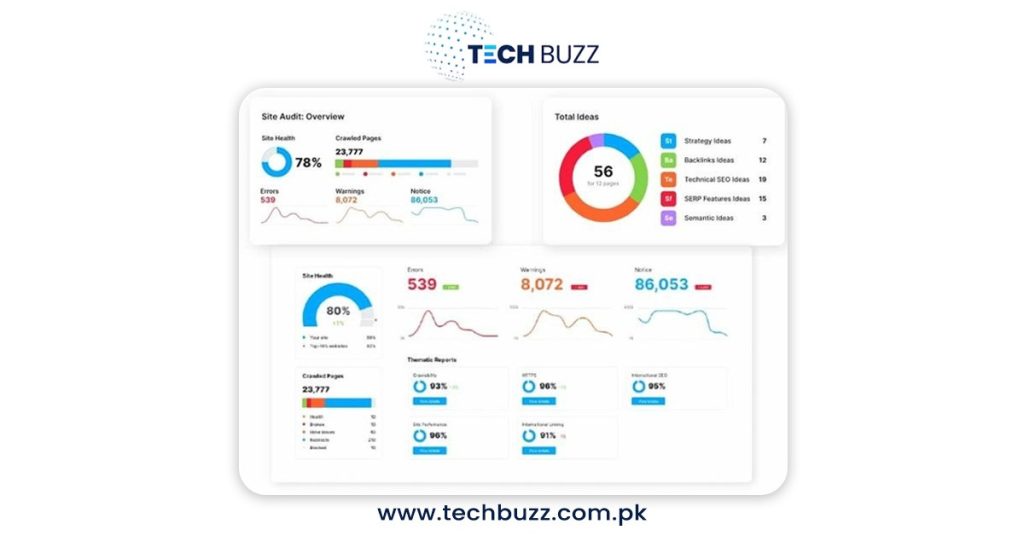
Manually checking every page of a website is nearly impossible, especially for large or growing platforms. That’s where specialized SEO audit tools step in. These tools automate technical checks, identify on-page issues, and provide in-depth data to help you make smarter SEO decisions. Here are some of the most powerful and in-demand SEO audit tools that will continue to dominate the digital space in 2025:
1. Screaming Frog SEO Spider
What It Does:
Screaming Frog is a desktop-based SEO audit tool that crawls websites like a search engine. It delivers a detailed analysis of every page it scans—from broken links and duplicate content to redirects, meta tags, and page status.
Why It’s Powerful:
- Crawls up to 500 URLs for free; unlimited with paid version.
- Identifies technical SEO issues like missing headers, duplicate pages, and non-indexable URLs.
- Integrates with Google Analytics and Search Console for deeper insights.
- Exports customizable reports in bulk for agency or in-house teams.
Why It’s In-Demand for 2025:
With Google placing more emphasis on site structure, crawlability, and user experience, Screaming Frog continues to be a gold-standard tool for SEOs needing detailed on-site diagnostics.
2. Ahrefs Site Audit Tool
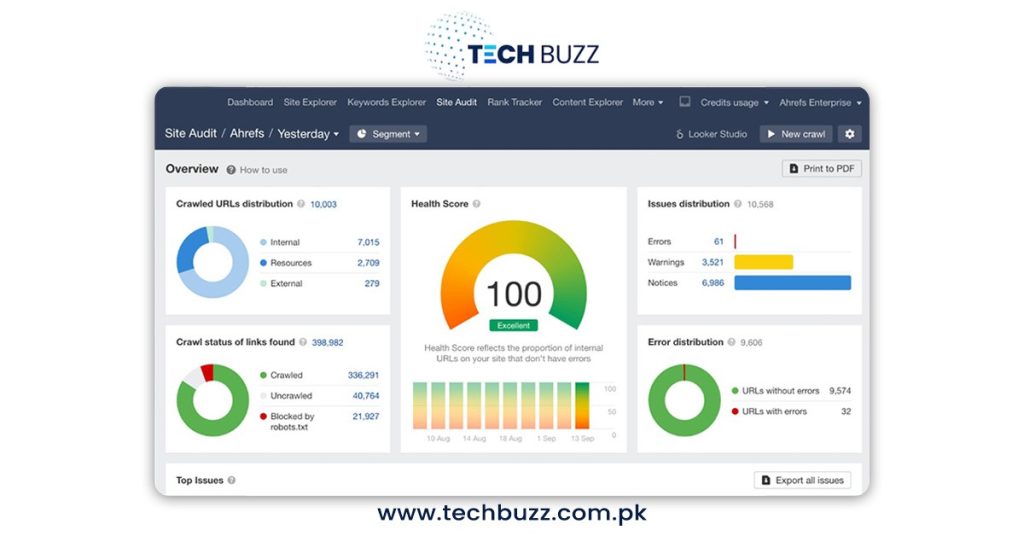
What It Does:
Ahrefs offers a cloud-based site audit tool that identifies over 100+ SEO issues, including crawl errors, performance issues, poor mobile usability, and content gaps.
Why It’s Powerful:
- Comprehensive crawl diagnostics with visuals and health scores.
- Tracks internal linking issues, content quality, JavaScript rendering, and more.
- Real-time alerts and suggestions to fix issues quickly.
- Cross-links with Ahrefs’ keyword and backlink tools for a 360-degree SEO approach.
Why It’s In-Demand for 2025:
Ahrefs is expanding its ecosystem rapidly, making it one of the most robust all-in-one SEO platforms. As AI and machine learning continue to shape search algorithms, Ahrefs’ precision insights will be vital for data-driven SEO planning.
3. Semrush Site Audit
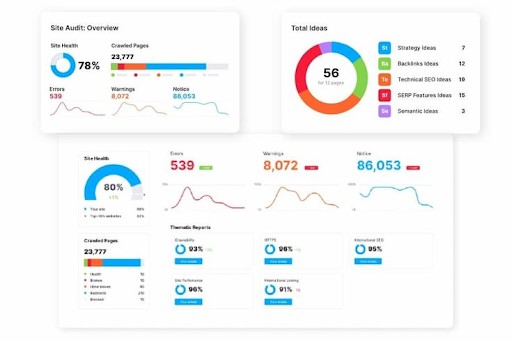
What It Does:
Semrush audits your entire site for more than 130 SEO issues and provides easy-to-follow fixes with helpful suggestions based on SEO best practices.
Why It’s Powerful:
- Auto-scheduled crawls and weekly health check summaries.
- Mobile SEO analysis, HTTPS security checks, and structured data reporting.
- Prioritizes issues based on impact on SEO performance.
- Integrates with competitor data for benchmarking.
Why It’s In-Demand for 2025:
Semrush is ideal for content marketers, agencies, and enterprises due to its expansive database and user-friendly dashboards that streamline audit workflows.
4. Google Search Console

What It Does:
It’s not flashy, but it’s free and incredibly effective. Google Search Console offers insights directly from the search engine itself, highlighting crawl errors, index status, mobile usability, and search performance.
Why It’s Powerful:
- Unmatched data accuracy since it comes straight from Google.
- Shows keywords driving impressions and clicks.
- Alerts for manual penalties and coverage issues.
- Essential for monitoring Core Web Vitals and Page Experience signals.
Why It’s In-Demand for 2025:
With continued focus on user experience and mobile performance, Search Console will remain a must-have baseline tool for SEO professionals.
5. Sitebulb
What It Does:
Sitebulb is a desktop-based crawler known for its visual reports and detailed audits tailored for advanced SEOs.
Why It’s Powerful:
- Combines data with visual graphs and flowcharts for easier interpretation.
- Highlights priority fixes using a scoring system.
- Offers JavaScript crawling and advanced performance metrics.
- Great for agencies that need client-friendly reporting.
Why It’s In-Demand for 2025:
With its unique UX and visualization features, Sitebulb stands out for teams that want in-depth technical insights without overwhelming spreadsheets.
How to Create a Simple SEO Audit Report in 2025
If you’re new to SEO, creating an audit report might feel overwhelming. But don’t worry, it’s easier than you think. An SEO audit is like a health check-up for your website. It tells you what’s working well and what needs fixing so your site can rank better on Google.
Here’s how to build a practical and beginner-friendly SEO audit report:
What to Include in Your SEO Audit Report
Basic Info
- Website name
- Date of the audit
- Who is doing the audit
Website Health Overview
- Give your website a score from 1–100 (you can get this from tools like Semrush, Ahrefs, or Screaming Frog).
- Mention if there are serious issues that need fixing quickly.
Main Issues (Make a Simple List)
- Example: “5 pages have missing titles”
- “Website takes 4 seconds to load (should be under 2 seconds)”
- “The mobile version has errors on the contact page.”
SEO Categories to Review
Break your audit into four simple parts:
Technical SEO
Are search engines able to read and load your site properly?
- Check site speed
- Make sure pages are being indexed
- Look for broken links
On-Page SEO
Is each page using keywords correctly?
- Fix missing titles and descriptions
- Add alt text to images
- Use proper heading tags (like H1, H2)
Content Review
Is your content helpful, original, and updated?
- Remove or improve weak pages
- Update old blog posts
- Add keywords people search for
Backlinks
Are other websites linking to you?
- Check for spammy links
- See how many sites are linking to your content
- Compare your backlinks with competitors
Action Plan
- Write what needs to be fixed and when.
- Mark priority levels (High / Medium / Low).
Example:
- Fix loading speed (High – this week)
- Add missing image alt tags (Medium – next week)
Sample Report Format
SEO Audit for: TechbuzzCometitors.com
Date: May 2025
Done by: TechBuzz SEO Team
Technical: Section 1
- Website loads in 4.3 seconds – needs improvement
- 12 broken links found
- Sitemap submitted correctly
On-Page: Section 2
- 8 pages missing meta titles
- 5 images missing alt text
- Headings are not used properly on blog pages
Content: Section 3
- 3 blog posts outdated – need updates
- 2 product pages have duplicate content
- Homepage content is relevant and updated
Backlinks: Section 4
- 48 total backlinks
- 3 low-quality links flagged
- Competitor has 120 backlinks (room for growth)
Action Steps: Section 5
- Fix loading speed (High Priority – May 5th)
- Add meta tags to 8 pages (Medium – May 10th)
- Update blog posts (Low – May 15th)
Real-Time Example: A Startup’s SEO Audit in Action
Imagine a SaaS startup with a sleek website but little traffic. After running a SEO audit report sample using Google tools:
- They found over 30% of their pages had no meta description.
- Several pages were not mobile-friendly, affecting Page Rendering.
- Their internal linking was weak, with orphaned pages floating on the site.
- Their loading speed on mobile devices was 7.2 seconds, way above the 3-second benchmark.
By fixing these, the startup saw a 45% increase in Organic Traffic in 3 months.
SEO Audit Checklist for 2025
Presented by TechBuzz
A comprehensive SEO audit report format ensures your website is fully optimized for search engine visibility, user experience, and long-term growth. Use this checklist to systematically evaluate and improve your site’s SEO performance.
Technical SEO Insights
Lay a strong foundation by addressing site structure and performance.
- Analyze site speed using tools like GTmetrix or PageSpeed Insights
- Verify mobile compatibility through Google’s mobile-friendly test
- Implement secure browsing with a valid SSL certificate (HTTPS)
- Ensure your XML sitemap is updated and submitted in Google Search Console
- Locate and resolve 404 errors and broken links
- Review and adjust your robots.txt to avoid accidental page blocking
- Confirm pages are being indexed and crawled correctly
On Page SEO Optimization
Optimize content and structure for both users and on page seo checker.
- Craft unique, keyword-aligned title tags for each page
- Write concise, action-driven meta descriptions
- Organize content using a clear heading structure (H1, H2, H3)
- Naturally incorporate keywords without over-optimization
- Add internal links to guide users and pass link equity
- Use clean, readable URLs with proper keyword placement
- Include descriptive alt tags for all images
Content Excellence
Elevate your content by focusing on relevance, originality, and authority.
- Refresh old posts and remove irrelevant content
- Identify and fix duplicate or low-value pages
- Prioritize E-E-A-T to build trust and authority
- Create informative and engaging long-form content
- Enhance posts with visual media like charts, videos, or graphics
Off-Page & Link Strategy
Strengthen your domain’s reputation through high-quality external connections.
- Monitor and evaluate your backlink profile with Ahrefs or SEMrush
- Remove toxic backlinks through the disavow process
- Research and replicate top competitor backlink tactics
- Build valuable links through relationship outreach and PR
- Share quality content to attract natural mentions and shares
Analytics & Performance
Use data to measure SEO efforts and guide future strategy.
- Set up and configure Google Analytics 4
- Establish conversion goals (sales, leads, subscriptions)
- Monitor key metrics such as bounce rate, session duration, and user flow
- Analyze heatmaps and user behavior via tools like Hotjar or Microsoft Clarity
- Create and review monthly SEO performance reports
Essential SEO Tools for 2025
Stay ahead with cutting-edge tools designed for evolving SEO challenges.
- Screaming Frog: Comprehensive technical audit and site crawl analysis
- Ahrefs / SEMrush: Advanced keyword research, backlink analysis, and competitor tracking
- Google Search Console: Visibility, indexing, performance, and security insights
- Surfer SEO / Frase: AI-powered content optimization and on-page improvements
- PageSpeed Insights: Page speed diagnostics with actionable suggestions
Conclusion
In 2025, a high-performing website starts with a smart SEO audit strategy. Whether you’re doing a basic check with a free SEO audit tool or diving deep with a technical SEO audit, staying consistent is the key. It’s not about doing everything at once, but about identifying the biggest impact points and fixing them.
Use tools wisely, follow a clear SEO audit checklist, and always keep improving. With regular audits, you’ll enjoy more organic traffic checker, better site performance, and a stronger digital presence.
How often should I conduct an SEO audit?
For growing businesses, it's best to perform a full SEO site audit at least every quarter. If you're in a competitive industry, monthly mini-audits using tools like Google Search Console are ideal.
Can I use a free SEO audit tool instead of paid options?
Yes. Many tools like Google Analytics, PageSpeed Insights, and Search Console offer detailed, reliable insights. However, for deeper insights, a premium SEO audit tool can save time and offer broader metrics.
What is the most important part of an SEO audit?
Each part matters, but the technical SEO audit is foundational. If your site isn’t crawlable or indexable, no amount of content or keywords will help. Start technical, then move to on-page and content.


I think this is one of the most vital info for me.
And i’m glad reading your article. But wanna remark on some general
things, The web site style is perfect, the articles is really nice : D.
Good job, cheers